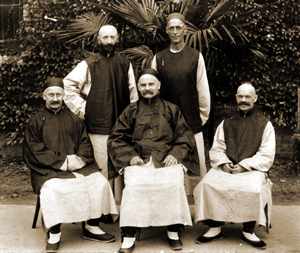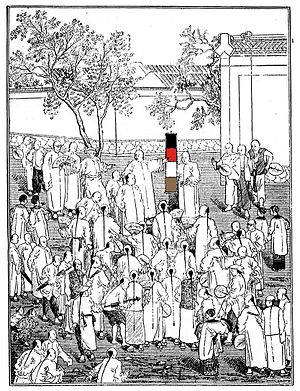
Charles Haddon Spurgeon was an English Particular Baptist preacher. Spurgeon remains highly influential among Christians of various denominations, to some of whom he is known as the "Prince of Preachers." He was a strong figure in the Reformed Baptist tradition, defending the 1689 London Baptist Confession of Faith, and opposing the liberal and pragmatic theological tendencies in the Church of his day.

Evangelism or witnessing is the act of preaching the Christian gospel with the intention of sharing the message and teachings of Jesus Christ. It is sometimes associated with Christian missions.
This timeline of Christian missions chronicles the global expansion of Christianity through a listing of the most significant missionary outreach events.

Reformed Baptists, Particular Baptists and Calvinistic Baptists, are Baptists that hold to a Calvinist soteriology. Depending on the denomination, Calvinistic Baptists adhere to varying degrees of Reformed theology, ranging from simply embracing the Five Points of Calvinism, to accepting a modified form of federalism; all Calvinistic Baptists reject the classical Reformed teaching on infant baptism. While the Reformed Baptist confessions affirm views of the nature of baptism similar to those of the classical Reformed, they reject infants as the proper subjects of baptism. The first Calvinistic Baptist church was formed in the 1630s. The 1689 Baptist Confession of Faith is a significant summary of the beliefs of Reformed Baptists. The name "Reformed Baptist" dates from the latter part of the 20th century to denote Baptists who retained Baptist ecclesiology, and reaffirmed Reformed biblical theology, such as Covenant theology.

The Metropolitan Tabernacle is a large independent Reformed Baptist church in the Elephant and Castle in London. It was the largest non-conformist church of its day in 1861. The Tabernacle fellowship has been worshipping together since 1650. Its first pastor was William Rider; other notable pastors and preachers include Benjamin Keach, John Gill, John Rippon and C. H. Spurgeon. The present pastor is Peter Masters.

Open-air preaching, street preaching, or public preaching is the act of evangelizing a religious faith in public places. It is an ancient method of proselytizing a religious or social message and has been used by many cultures and religious traditions, but today it is usually associated with evangelical Protestant Christianity. Supporters of this approach note that both Jesus and many of the Old Testament prophets often preached about God in public places. It is one of the oldest approaches to evangelism.

James Hudson Taylor was a British Protestant Christian missionary to China and founder of the China Inland Mission. Taylor spent 54 years in China. The society that he began was responsible for bringing over 800 missionaries to the country who started 125 schools and directly resulted in 20,000 Christian conversions, as well as the establishment of more than 300 stations of work with more than 499 local helpers in all 18 provinces.

The Cambridge Seven were six students from Cambridge University and one from the Royal Military Academy, who in 1885, decided to become missionaries to China through the China Inland Mission. The seven were:
OMF International is an international and interdenominational Evangelical Christian missionary society with an international centre in Singapore. It was founded in Britain by Hudson Taylor on 25 June 1865.
Christians have used many different approaches to spread Christianity via the practice of evangelism. Christianity began with only a few different evangelistic approaches, but over the years, many different forms of evangelism have been employed by various groups to spread their faith. Many of these forms of evangelism are often employed in only certain parts of the world by Christians in different geographical areas. In particular, most new approaches to evangelism today have arisen out of Europe or the United States, especially when new technologies are used for the effort of evangelism.

In the early 19th century, Western colonial expansion occurred at the same time as an evangelical revival – the Second Great Awakening – throughout the English-speaking world, leading to more overseas missionary activity. The nineteenth century became known as the Great Century of modern religious missions.

Wang Laiquan or Wang Laijun (王来俊) (1835-) was a Chinese Protestant Christian pastor and missionary in Hangzhou, Zhejiang, China in the late 19th century. "One of China's great, if unsung Christians, after Pastor Xi Shengmo... he was perhaps the most notable Chinese connected with the China Inland Mission."

China’s Spiritual Need and Claims is a book written by James Hudson Taylor, the founder of the China Inland Mission, in October 1865.
William Garrett Lewis (1821–1885) was a Baptist preacher and pastor of Westbourne Grove Church in Bayswater, London for 33 years. He was an apologist author of two books, Westbourne Grove Sermons and The Trades and Industrial Occupations of the Bible, published by the Religious Tract Society.
The Sheo Yang Mission was a Protestant Christian missionary society that was involved in sending workers to China during the late Qing dynasty. It was founded by the Pigott family in 1892, they had previously been members of the China Inland Mission (CIM). The mission was destroyed and most members murdered in 1900, the work continued through the Baptist Missionary Society.
William Young Fullerton was a Baptist evangelist, administrator and writer. He was born in Belfast, Ireland. As a young man, he was influenced by the preaching of Charles Spurgeon, who became his friend and mentor. Fullerton served as President of the Baptist Union and Home Secretary of the Baptist Missionary Society. He was a frequent speaker at Keswick Conventions. His published works include biographies of John Bunyan, Charles Spurgeon, James William Condell Fegan and Frederick Brotherton Meyer; missionary histories and devotional writings. He also compiled several hymnals. He is remembered for his hymn entitled "I Cannot tell why He, whom angels worship", which he set to the traditional Irish melody "Londonderry Air". He died at Bedford Park, Middlesex, at the age of 75.

The "China Martyrs of 1900" is a term used by some Protestant Christians to refer to American and European missionaries and converts who were murdered during the Boxer Rebellion, when Boxers carried out violent attacks targeting Christians and foreigners in northern China.
Characteristic of Christianity in the 19th century were evangelical revivals in some largely Protestant countries and later the effects of modern biblical scholarship on the churches. Liberal or modernist theology was one consequence of this. In Europe, the Roman Catholic Church strongly opposed liberalism and culture wars launched in Germany, Italy, Belgium and France. It strongly emphasized personal piety. In Europe there was a general move away from religious observance and belief in Christian teachings and a move towards secularism. In Protestantism, pietistic revivals were common.
The salvation bracelet, also known as the gospel bracelet, witness bracelet, or wordless bracelet, is a bracelet used as a tool of Christian evangelism. The bracelet consists of a series of colored beads which represent key aspects of the Christian gospel.












